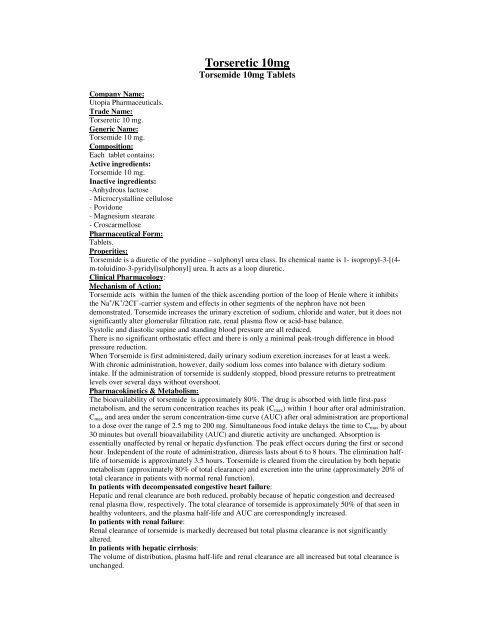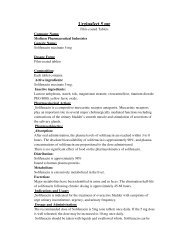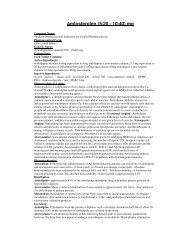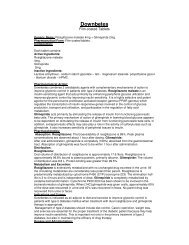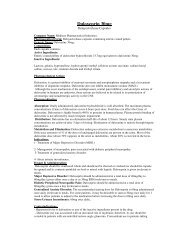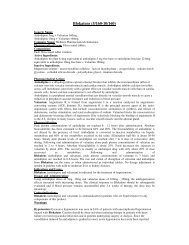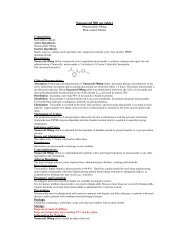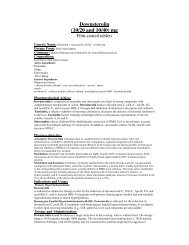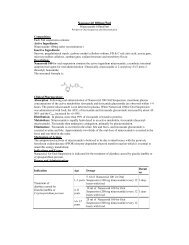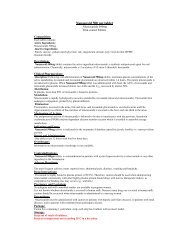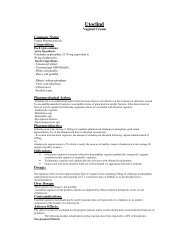Torseretic Active Ingredient: Torsemide Uses - Utopia Pharmaceuticals
Torseretic Active Ingredient: Torsemide Uses - Utopia Pharmaceuticals
Torseretic Active Ingredient: Torsemide Uses - Utopia Pharmaceuticals
You also want an ePaper? Increase the reach of your titles
YUMPU automatically turns print PDFs into web optimized ePapers that Google loves.
<strong>Torseretic</strong> 10mg<br />
<strong>Torsemide</strong> 10mg Tablets<br />
Company Name:<br />
<strong>Utopia</strong> <strong>Pharmaceuticals</strong>.<br />
Trade Name:<br />
<strong>Torseretic</strong> 10 mg.<br />
Generic Name:<br />
<strong>Torsemide</strong> 10 mg.<br />
Composition:<br />
Each tablet contains:<br />
<strong>Active</strong> ingredients:<br />
<strong>Torsemide</strong> 10 mg.<br />
Inactive ingredients:<br />
-Anhydrous lactose<br />
- Microcrystalline cellulose<br />
- Povidone<br />
- Magnesium stearate<br />
- Croscarmellose<br />
Pharmaceutical Form:<br />
Tablets.<br />
Properities:<br />
<strong>Torsemide</strong> is a diuretic of the pyridine – sulphonyl urea class. Its chemical name is 1- isopropyl-3-[(4-<br />
m-toluidino-3-pyridyl)sulphonyl] urea. It acts as a loop diuretic.<br />
Clinical Pharmacology:<br />
Mechanism of Action:<br />
<strong>Torsemide</strong> acts within the lumen of the thick ascending portion of the loop of Henle where it inhibits<br />
the Na + /K + /2CI − -carrier system and effects in other segments of the nephron have not been<br />
demonstrated. <strong>Torsemide</strong> increases the urinary excretion of sodium, chloride and water, but it does not<br />
significantly alter glomerular filtration rate, renal plasma flow or acid-base balance.<br />
Systolic and diastolic supine and standing blood pressure are all reduced.<br />
There is no significant orthostatic effect and there is only a minimal peak-trough difference in blood<br />
pressure reduction.<br />
When <strong>Torsemide</strong> is first administered, daily urinary sodium excretion increases for at least a week.<br />
With chronic administration, however, daily sodium loss comes into balance with dietary sodium<br />
intake. If the administration of torsemide is suddenly stopped, blood pressure returns to pretreatment<br />
levels over several days without overshoot.<br />
Pharmacokinetics & Metabolism:<br />
The bioavailability of torsemide is approximately 80%. The drug is absorbed with little first-pass<br />
metabolism, and the serum concentration reaches its peak (C max ) within 1 hour after oral administration.<br />
C max and area under the serum concentration-time curve (AUC) after oral administration are proportional<br />
to a dose over the range of 2.5 mg to 200 mg. Simultaneous food intake delays the time to C max by about<br />
30 minutes but overall bioavailability (AUC) and diuretic activity are unchanged. Absorption is<br />
essentially unaffected by renal or hepatic dysfunction. The peak effect occurs during the first or second<br />
hour. Independent of the route of administration, diuresis lasts about 6 to 8 hours. The elimination halflife<br />
of torsemide is approximately 3.5 hours. <strong>Torsemide</strong> is cleared from the circulation by both hepatic<br />
metabolism (approximately 80% of total clearance) and excretion into the urine (approximately 20% of<br />
total clearance in patients with normal renal function).<br />
In patients with decompensated congestive heart failure:<br />
Hepatic and renal clearance are both reduced, probably because of hepatic congestion and decreased<br />
renal plasma flow, respectively. The total clearance of torsemide is approximately 50% of that seen in<br />
healthy volunteers, and the plasma half-life and AUC are correspondingly increased.<br />
In patients with renal failure:<br />
Renal clearance of torsemide is markedly decreased but total plasma clearance is not significantly<br />
altered.<br />
In patients with hepatic cirrhosis:<br />
The volume of distribution, plasma half-life and renal clearance are all increased but total clearance is<br />
unchanged.
Indications:<br />
<strong>Torsemide</strong> is indicated for the treatment of edema associated with congestive heart failure, renal<br />
disease, or hepatic disease. Use of torsemide has been found to be effective for the treatment of edema<br />
associated with chronic renal failure. Chronic use of any diuretic in hepatic disease has not been<br />
studied in adequate and well-controlled trials.<br />
<strong>Torsemide</strong> is indicated for the treatment of hypertension alone or in combination with other<br />
antihypertensive agents.<br />
Dosage and Adminstration:<br />
<strong>Torsemide</strong> tablets may be given at any time regardless to food, as convenient. Special dosage<br />
adjustment in the elderly is not necessary because of the high bioavailability of torsemide.<br />
Essential Hypertension:<br />
In patients with essential hypertension, torsemide has been shown to lower blood pressure when<br />
administered once a day at doses of 5 mg to 10 mg. The antihypertensive effect is near maximal after 4<br />
to 6 weeks of treatment, but it may continue to increase for up to 12 weeks.<br />
<strong>Torsemide</strong> has been administered together with (beta)-adrenergic blocking agents, ACE inhibitors, and<br />
calcium-channel blockers. Adverse drug interactions have not been observed, and special dosage<br />
adjustment has not been necessary.<br />
<strong>Torsemide</strong> initial dose is 5 mg once daily. If the 5 mg dose does not provide adequate reduction in<br />
blood pressure within 4 to 6 weeks, the dose may be increased to 10 mg once daily. If the response to<br />
10 mg is insufficient, an additional antihypertensive agent should be added to the treatment regimen.<br />
Congestive Heart Failure:<br />
<strong>Torsemide</strong> initial dose is 10 mg or 20 mg once daily. If the diuretic response is inadequate, the dose<br />
should be titrated upward by approximately doubling until the desired diuretic response is obtained.<br />
Single doses higher than 200 mg have not been adequately studied.<br />
Chronic Renal Failure:<br />
<strong>Torsemide</strong> initial dose is 20 mg once daily. If the diuretic response is inadequate, the dose should be<br />
titrated upward by approximately doubling until the desired diuretic response is obtained. Single doses<br />
higher than 200 mg have not been adequately studied.<br />
Hepatic Cirrhosis:<br />
<strong>Torsemide</strong> initial dose is 5 mg or 10 mg once daily administered together with an aldosterone<br />
antagonist or a potassium-sparing diuretic. If the diuretic response is inadequate, the dose should be<br />
titrated upward by approximately doubling until the desired diuretic response is obtained. Single doses<br />
higher than 40 mg have not been adequately studied.<br />
Contraindications:<br />
-<strong>Torsemide</strong> is contraindicated in patients with known hypersensitivity to sulfonylureas.<br />
-<strong>Torsemide</strong> is contraindicated in patients who are anuric.<br />
Side Effects:<br />
The reported side effects of torsemide were generally transient and there was no relationship between<br />
side effects and age, sex, race or duration of therapy. The most common side effects (in descending<br />
order of frequency) dizziness, headache, nausea, weakness, vomiting, hyperglycemia, excessive<br />
urination, hyperuricemia, hypokalemia, excessive thirst, hypovolemia, impotence, esophageal<br />
hemorrhage and dyspepsia. Drop out rates for these adverse events ranged from 0.1% to 0.5%.<br />
Drug Interactions:<br />
-In patients with essential hypertension, torsemide has been administered together with beta-blockers,<br />
ACE inhibitors and calcium-channel blockers. In patients with congestive heart failure, torsemide has<br />
been administered together with digitalis glycosides, ACE inhibitors and organic nitrates. None of<br />
these combined uses were associated with new or unexpected adverse events.<br />
-<strong>Torsemide</strong> does not affect the protein binding of glyburide or of warfarin, the anticoagulant effect of<br />
phenprocoumon (a related coumarin derivative), or the pharmacokinetics of digoxin or carvedilol (a<br />
vasodilator/beta-blocker). In healthy subjects, coadministration of torsemide was associated with<br />
significant reduction in the renal clearance of spironolactone with corresponding increases in the AUC.<br />
However, clinical experience indicates that dosage adjustment of either agent is not required. Possible<br />
interaction with high doses of salicylates may occur.<br />
Pregnancy:<br />
This drug should be used during pregnancy only if clearly needed.<br />
Nursing mothers:<br />
It is not known whether torsemide is excreted in human milk. Because many drugs are excreted in<br />
human milk, caution should be exercised when administered to a nursing woman.<br />
Warnings & Precautions:
Hepatic coma, pediatric use, hypokalemia.<br />
Package:<br />
Carton box containing 3 pvdc/aluminum strips. Each strip is 10 tablets with insert leaflet.<br />
Storage:<br />
keep out of reach of children.<br />
keep at a temperature not exceeding 30°C in a dry place.<br />
Information for Patients:<br />
- Keep this leaflet. You may need to read it again.<br />
- If you have any further questions, ask you doctor or pharmacist.<br />
- This medicine has been prescriped for you. Do not pass it on to others; it may harm them, even if<br />
their symptoms are the same as yours.<br />
- If any of the side effects gets serious, or if you notice any side effects not listed in this leaflet, please<br />
tell your doctor or pharmacist.<br />
- Don't stop torsemide suddenly, blood pressure will return to pretreatment levels.<br />
Produced by Medizen Pharmaceutical Industries for <strong>Utopia</strong> <strong>Pharmaceuticals</strong>.


